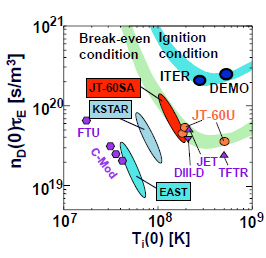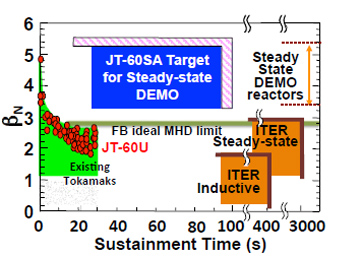Operation
When fully operational, JT-60SA will be able to sustain break-even-equivalent high-temperature deuterium plasmas for typically 100 s, longer than the timescales characterising key plasma processes such as current diffusion and particle recycling. The maximum plasma current is 5.5 MA. The device can also pursue fully non-inductive steady-state operation with values of the plasma pressure exceeding plasma stability limits, without wall-stabilisation.
Its performance range, compared to other experiments worldwide, as well as with expected ITER and DEMO operation, is shown below (nD(0) = plasma central ion density, τE = energy confinement time, Ti(0) = plasma central ion temperature, ßN = normalised beta)


JT-60SA’s mission has to be achieved first with carbon components facing the plasma. Once the integrated plasma control systems are sufficiently mature, the divertor target and the first wall will be replaced by tungsten-coated carbon. Under this ‘metal-wall’ environment, JT-60SA’s missions to support ITER operation, and to complement ITER operation in extrapolating to DEMO, will be investigated.
The JT-60SA Research Plan, evolved in the fusion communities in Japan and Europe, has been formulated to address major issues in ITER and DEMO. Details of the immediate plan are described below.

Initial Research Phase I
H.I.1. Stable operation at high current in a large superconducting machine
- Current ramp-up scenario development up to full-current operation
- Plasma shape and equilibrium control avoiding vertical instability
- Locked mode and kink mode avoidance during current ramp-up
- Electron cyclotron wall conditioning
- Light and heavier impurity control in the core
- H-mode plasma operation
H.I.2. ITER risk mitigation for non-activated phase
- Basic disruption studies
- L-H mode transition studies in hydrogen/helium plasmas
Initial Research Phase II
H.II.1. ITER plasma scenario development
To prepare ITER-relevant plasma scenarios
- Sawtooth period real-time control by electron cyclotron current drive
- Neoclassical tearing mode real-time control by electron cyclotron current drive
- High density H-mode operation
- Light and heavier impurity transport and control in the core
In the ITER relevant plasma scenarios
- Dominant electron heating in H-mode plasmas
- Intrinsic torque and intrinsic plasma rotation studies
- Isotope studies by comparison of hydrogen and deuterium plasmas
- L-H mode transition, pedestal physics and scalings
- Energetic particle driven mode studies
- Energetic particle effects on transport and confinement
- Detachment physics and code validation
H.II.2. Steady-state high beta plasma scenario development
To prepare the high beta plasma scenarios
- Current drive optimisation
- Simultaneous stabilisation of resistive wall mode and neoclassical tearing mode
- Real-time kinetic profile control development
- Impurity transport with peaked density profiles
- Fuelling and pumping for density control
- Protecting target plates by detached divertor
In the high beta plasma scenarios
- Self-organisation studies of current, pressure and rotation profiles
- Internal transport barrier and intrinsic rotation studies
- Fast ion effects on turbulence and transport
- Anomalous heating by magnetohydrodynamic mode damping
- Fast particle driven modes instability
- Compatibility of small/no edge localised mode and high beta
H.II.3. ITER risk mitigation
- Disruption avoidance
- Runaway electron study at high current
- H-mode operational boundaries
- Edge localised mode mitigation/suppression
- Compatibility of resonance magnetic pumping with fast ion confinement
- Scrape-off layer width scaling
- Burning plasma simulation experiment
- Hydrogen/deuterium ratio control by gas-puff and pellet
- Helium pumping
Following this initial research phase, pulse duration and plasma parameters in both pulsed and steady state operating scenarios will be expanded taking advantage of the monoblock divertors and higher heating power expected to be available in the Integrated Research Phase I. The compatibility of high density, high beta, high confinement and a radiative divertor will be explored using the upgraded power and divertor performance. The physics and controllability of self-regulating and self-organising plasmas will be addressed with long-pulse operation. By organising and integrating the observations, fully non-inductive steady-state operation above the no-wall ideal MHD stability limits will be accomplished. Finally, scenarios compatible with the future metal wall configuration will be investigated and prepared.
Metal wall experiments will begin after the mission goal and major objectives are achieved. This is planned for the Integrated Research Phase II to support the ITER full power phase. Major objectives will be integrated power/particle exhaust studies and real-time control of a divertor which is compatible with high beta plasmas. These experimental observations and theoretical models will contribute to developing reliable ITER operation and the basis for DEMO design.
